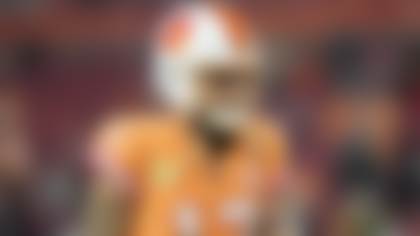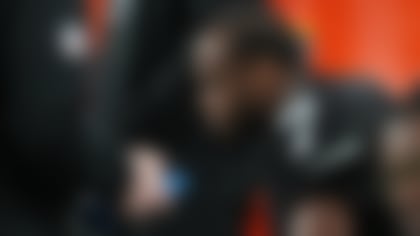NFL Media's Albert Breer touches on multiple topics in his robust Inside the NFL Notebook, including (click on each link to go directly to the topic):
» Could this season be the last stand for the current regime in Indy?
» The awesome motivational power of Rex Ryan.
» Two intriguing college prospects to scout on Saturday.
And much more, beginning with some valuable perspective on the first two picks of the 2015 NFL Draft ...
Buccaneers GM Jason Licht remembers clearly when he knew Tampa Bay would take Jameis Winston with the first pick.
The coaches gave Winston a game plan to digest during his visit to Tampa in March, and steadily piled more on his plate during the process, right up through April classroom work in Tallahassee. After that last session, they took him out to the field. Winston hadn't taken many -- if any -- notes. And yet, as Licht remembers it, "We asked, and he gave it all back to us, everything from the first workout, 100 percent."
Tennessee GM Ruston Webster had a similar moment earlier that month with Marcus Mariota. Titans coaches had him in the film room, where it was apparent how well-versed he was in Oregon's system. So they threw him more. Ninety minutes later, Mariota was able to apply the new stuff -- NFL stuff -- physically during his private workout.
On top of that, the reigning Heisman winner's teammates waited through Mariota's meetings to help him during his on-field work, and hardly made that seem like a chore.
"There was a very relaxed, positive feel to it," Webster said on Wednesday. "I liked that."
So Winston went first, Mariota went second, and they met again last Sunday in Tampa. Both GMs took things from this most recent experience, too. But not nearly as much.
In the wake of that highly publicized rookie showdown, I did a little research over the last few days. I went back and looked at how every first-round quarterback since 2000 debuted, searching for any -- any -- lasting meaning.
Honestly, there's not much there.
Eighteen of those quarterbacks played in Week 1 of Year 1. How'd they do? Take a look:
Four posted a passer rating over 100: Matt Ryan, Cam Newton, Robert Griffin III and EJ Manuel. Five had a passer rating south of 50: Michael Vick, Joey Harrington, Matthew Stafford, Ryan Tannehill and Brandon Weeden (Tim Tebow didn't throw a pass in his first outing).
As you can also see in the box above, I looked at how those 18 players performed over the entirety of their respective rookie seasons. Interesting to remember that, just three years ago, Griffin's passer rating was 102.4, while Andrew Luck and Tannehill finished in the mid-70s.
On Sunday, Mariota was masterful and Winston wasn't. It's fun that we had that matchup in Week 1, and those in Nashville probably felt a lot better on Monday morning than folks in Tampa. But if history is any sort of guide, choosing to draw sweeping conclusions from what we saw at Raymond James Stadium last week would probably land somewhere between blind and stupid.
And no one knows that better than the guys who picked the quarterbacks.
"There's no getting around it: (Winston) didn't play well," Licht said on Thursday. "We saw some flashes of great play. Overall, he didn't play well. But in no way, shape or form are we upset with the pick. We'd do it again in a second. We love the guy and we have a lot of faith in him. It's a great part of the learning process. He's never been in a game like that before. And talking to the guys who were on the sideline, he truly believed he could get us back in it, right until the end.
"He knows now that, on this level, he's not gonna be able to do it on his own."
Winston's first mistake came on his first play of the game: He predetermined where he was going with the ball before the snap, locked on to his primary read and was picked off by Coty Sensabaugh, who ran the other way for a touchdown. Winston should've been more patient. He knows that now.
Meanwhile, the defense was struggling, and the game quickly got away from the Bucs. Winston was sacked four times (two of them were on the rookie QB). The score worked to neutralize the Tampa run game. Still, within an hour of the final gun, Winston was back in the classroom. He had his best practice as a Buc on Wednesday, showing the kind of resiliency he put on tape after interceptions last year at Florida State.
"The guy has to be able to digest information, bounce back from a bad day, go over his mistakes, and get another pile of plays and install them," Licht said. "We knew pretty early on he'd be able to do that."
Conversely, Mariota came away from Sunday with much less to correct.
The Titans incorporated some Oregon concepts and single-read throws to get him going. And boy, did he ever get going, on an occasion -- playing against the guy drafted ahead of him -- not everyone would rise to.
"It's just his poise -- that's what stands out about the way he played the most," Webster said. "He handled the first game, in a tough environment with a lot of hype. His poise stands out."
When asked about the progress that Mariota's made, Webster points to his interception in the preseason opener -- how the correction was made, and one problem didn't metastasize into more.
As for technical improvements, those have come in the most rudimentary areas. The scheme transition wasn't as dramatic as some made it out to be, with Oregon's spread incorporating far more pro-style passing concepts than, say, Baylor or Oklahoma do. "He was more prepared to play in the pocket than people realized, because they had him progression-read and stepping up in the pocket, and they did a good job with that," Webster explained.
He did, though, have to learn how to play under center and run a huddle, things quarterbacks used to learn in pee-wee ball. And he showed that progress, plus his natural ability, in the opener.
"He was very accurate, virtually every throw was," Webster said. "Our receivers see that. He's putting it on them. And they've seen it all along since he's been here in practice and preseason. He gets the ball out quick -- and on the money."
All of it came together in a 13-of-16, 209-yard, four-touchdown afternoon (dwarfing Winston's line of 16-of-33 for 210 yards, two TDs and two INTs). But Webster knows well enough, defenses will catch up with how the Titans are helping Mariota -- like they did against guys like Griffin and Colin Kaepernick -- and finding a counterpunch will be the key to sustaining the early flourish.
"The challenge will be staying one step ahead," Webster said. "It's one game. People will adjust to his style and defensive coaches in the NFL are so good, they'll find ways to make it tough on him. So he has to stay one step ahead."
To that end, as part of their draft process, the Bucs actually studied how other teams brought other quarterbacks through their systems and helped them grow up. They saw the success stories, and the ones that went off the rails. Now, they'll go about getting Winston back on them.
"We talked to a lot of our counterparts who took quarterbacks and asked them how they did it," Licht said. "The ones that made it. And the ones that didn't. And we're using that as part of our plan."
Asked what he learned through that research, the Bucs GM clammed up. That's proprietary.
But he would share this on the plan: It extends past Week 1.
Four downs
1) Colts crisis?: How to assign blame in what has fractured in Indianapolis now depends largely on who you want to believe. But how the Colts got here -- where a coach and GM are under fire despite three straight playoff runs, each ending a round deeper than the year before -- is something most people who've worked in Indy under this regime and the previous one agree on. Owner Jim Irsay's been here before. He had Peyton Manning for 14 years, and, according to those in the know, the fact that he only came away with one title over that period still haunts him. In that time, the Patriots won three titles, the Steelers and Giants two, and all of it has steeled his resolve to get more out of the seasons he has with Andrew Luck as his quarterback. There's been an assumption that this will lead to Irsay having an itchy trigger finger with his decision-making on his top decision-makers, a thought that's bolstered by Chuck Pagano's contract-year status. The Bill Polian era can be instructive here. In 2001, Edgerrin James went down, the Colts plunged to 6-10, Jim Mora refused to purge his defensive staff, and Irsay fired all the coaches. With the idea that Manning was, in effect, the offensive coordinator, Irsay focused on prospective head coaches who could shore up the defensive side of the ball, which is where Tony Dungy came in. A decade-and-a-half later, the Colts' defense has improved under Pagano, going from 26th to 20th to 11th in the past three seasons. But the unit was run over in all three playoff ousters, and didn't exactly show much promise for brighter days in the 2015 opener. You can argue here over whether it's the Jimmys-and-Joes or the X's-and-O's (and that's on both sides of the ball). But what seems increasingly undeniable is that Irsay -- scarred by past experiences -- will go looking to make changes if this season ends in the same way the last three did, with his team struggling to stand up physically to an elite opponent. (He'd point out the team is 16-2 within the division and 17-13 out of the division over the past three seasons.) And word around the campfire is that if Irsay does make a coaching change, he might be ready to go big-game hunting, which could change the structure of the organization.
2) Rex riles up the Bills. On NFL Network's "GameDay Morning" last Sunday, I detailed the speech Rex Ryan delivered to his players on Saturday night, ahead of his Bills debut vs. Indianapolis. According to a number of guys in the room, the crescendo went like this: "Why not us? Why not now? We're built to beat the (bleep) out of people. Let's go do it. Let's make the whole league feel our presence." It didn't hurt, in the aftermath, that Buffalo was able to pull off exactly what Ryan predicted: The Bills controlled the trenches on both sides of the ball and left the Colts, a conference finalist last year, bloodied and beaten. But that wasn't the only reason it resonated with the players. As veteran safety Aaron Williams explained, the guys feel like Ryan's putting everyone in position to do what they do best: "He wants us to succeed ... And puts others before himself." And so, with that ability to control the room in the coach's back pocket, the players felt like Ryan's Saturday night soliloquy did make a different. "I couldn't even sleep," Williams said. "I kept thinking about the speech. He was very confident we were gonna win this game, just like it happened. I mean, I was looking around the team meeting room, just seeing guys' faces light up. They were probably more anxious to play (Saturday) than (Sunday)."
3) Questions about Maxwell in Philly? Prior to the 2014 free agency period, I went looking for "rules" that teams follow before opening up their wallets and spending. One, in particular, really resonated with me: Be careful about projecting guys into bigger roles. That could mean making a No. 2 receiver your No. 1 (ex: Alvin Harper in Tampa) or a complementary pass rusher your primary guy (ex: Paul Kruger in Cleveland). "That's where the biggest mistakes are made," one NFC executive said at the time. "It's players on good teams who have better stats because of the cumulative team effect." I couldn't help but think of this watching Julio Jones and Byron Maxwell on Monday night. Maxwell fits Chip Kelly's parameters for corners to a T, but he only started 22 games (playoffs included) as a Seahawk, and had All-Pro pieces around him in the secondary. For his part, Maxwell fell on the sword when I asked about his matchup with Jones the other day: "A couple of pretty bad plays, and those are the ones that make or break a game." But he insisted the issues related to slip-ups in technique, which he sees as fixable. And while he acknowledged there's been a transition scheme-wise, he doesn't buy that moving up the roster food chain is a reason for his issues. "Nothing's changed, as far as that," he told me.
4) Credit where it's due for Romo: Part of being the Cowboys' quarterback is that every mistake is made on center stage, in front of the world, which is a reason why Tony Romoseems to have a long history of late-game failures. The truth? The near-perfect performance we saw when Dallas had to have it on Sunday -- Romo was 11-of-12 for 148 yards and two touchdowns (without Dez Bryant) in the last eight minutes of the Cowboys' win -- is closer to the long-term reality than you may realize. Romo leads the NFL with 28 game-winning drives since 2006, and his overall numbers in big spots are strong as anyone's. Since becoming starter in October of 2006, his fourth-quarter quarterback rating is a sparkling 102.4, which is behind only Aaron Rodgers (104.0) over that period, and ranks ahead of Peyton Manning (98.9) and Tom Brady (95.7). The difference, of course, is that the other three guys have rings and Romo doesn't, and that certainly hurts him in the category of clutch. But Sunday was just the latest example that, in the waning moments of a game, Romo's anything but a liability. "Tony is so good in those situations," tight end Jason Witten told 1310 The Ticket in Dallas this week. "(It's) his ability to get on the ball, call the play quickly, and then -- most importantly -- the way we were able to execute those final two drives."
Three checkdowns
1) The Vikings certainly didn't live up to expectations in Week 1, getting beaten up physically by a surprisingly spry 49ers group. The good news for the Vikings is they feel like the issues are pretty easily correctable. In general, there was a sense that plays where 10 players were going in the right direction and one was going the wrong way cost them. And Teddy Bridgewater missed some early throws. And so this week's home opener against Detroit is suddenly big for both teams, as the Lions suffered a disappointing loss in Week 1, as well.
2) The injury guarantee in Robert Griffin III's 2016 option -- worth a cool $16.2 million -- is important now. So how would it be applied? The crux of the matter is Griffin would have to be able to pass a physical if/when he's cut to get the club off the hook. And if he's on the roster on Day 1 of the '16 league year, the cash becomes fully guaranteed. Since there's grey area in what constitutes passing a physical, I dug through contracts from two clubs. Both had language saying that part of the judgment is "in the sole discretion of the club's physician."
3) I completely understand why the Seahawks have to take on Kam Chancellor in this holdout. Just the same, it's hard to blame any player for trying to get every dime he can while he's still physically able. But there's no denying the impact he has on the team. While Earl Thomas and Richard Sherman are bigger stars, Chancellor has long been the emotional heartbeat of the team's elite secondary. And he can play, too. The Seattle D bounced back from a slow start last year when Chancellor returned to the lineup. So while the Seahawks are plenty deep on defense, there's no denying this one hurts.
Two college players to watch Saturday
1) Cal QB Jared Goff (at Texas, 7:30 p.m. ET, FOX): Goff is running a race with three Big Ten QBs (Michigan State's Connor Cook, Penn State's Christian Hackenberg and Ohio State's Cardale Jones) that's still in its early stages, and this is one of those weeks where he can show up on a huge stage -- national TV, night game, against a defense that's beatable -- and enhance his name in the 2016 NFL Draft's QB conversation. All the top quarterbacks have flaws. There's no Andrew Luck in this group. Goff's are twofold. First, despite being 6-foot-4, he's somewhat slight and might not have the frame to put more weight on. Second, he comes from an offense that's a cousin of Baylor's spread, which will make the transition to the pros a challenge. "The jury's out on him -- spread offense, big arm, smart kid, good kid," an AFC personnel exec said. "From a scheme standpoint, he's behind the eight ball, and it may be best to sit him early on, unless he comes in and shows he's a genius. But he has one of the best arms of anyone coming out." Goff is the son of a former Major League Baseball player, and has the even demeanor you'd anticipate from a professional athlete's kid, so the expectation is he'll handle a stage like Saturday's fine. The bigger tests from a playing standpoint likely will come during the conference schedule. But at this point, he's seen as the best QB prospect in the Pac-12, going away.
2) Ole Miss WR Laquon Treadwell (at Alabama, 9:15 p.m. ET, ESPN): Treadwell has started a little slow, coming off one of the ugliest injuries the sport saw at any level last year -- a broken fibula and dislocated ankle ended the Rebel star's 2014 season -- so this would be a heck of a spot to turn a corner. At 6-2 and 210 pounds, the true junior is one of a fleet of pro prospects playing in this showdown, and his matchup with Tide corner Cyrus Jones is one scouts will hone in on. "He's a big, strong, physical receiver," said an AFC area scout assigned to the Rebels. "We'll all be looking to see how he progresses during the year." An AFC college director compared him, as a collegian, to Chicago's Alshon Jeffery, who was taken in the second round of the 2012 draft out of South Carolina: "He's a tough matchup all the way around. He's physical, competitive, has good hands." Like Jeffery once did, Treadwell has questions that leave some boxes to be checked off if he's got a shot to go in the first round. Another area scout said it'll likely come down to teams' comfort level with drafting a receiver who may run in the 4.6s. There seems to be little question, though, that he can play -- as can many others set to play in this one. The shame of it for the scouts is they won't see Rebel left tackle Laremy Tunsil. The first area scout said Tunsil "may be the most NFL-ready player to come out as a junior in a long time," but he has yet to play this season, as he's being investigated for potential violations of NCAA rules.
Extra point
It made news this week when word surfaced that St. Louis and San Diego -- the cities, not their teams -- would not be given an audience at next month's owners meetings in New York.
That meeting has long been treated as a major milepost in the path back to Los Angeles. And it is one, in a way. But not in the way that involving those municipalities -- trying to keep their football franchises -- need to be involved.
As far as planning for L.A. is concerned, this particular summit simply isn't the venue for discussion with the existing markets, with the feeling being that a committee setting -- rather than a full league meeting -- is more conducive to the necessary give-and-take.
So what could be negotiated in New York?
For one, a relocation fee could be agreed to, as well as how it would be paid out. For another, we could get the new relocation window finalized: It is expected to be moved up from where it is currently, running from Jan. 1 to Feb. 15. And finally, there's a chance owners could settle on a temporary 2016 site for whoever lands in Southern California -- with the Coliseum being the only obvious option now, though some believe the Rose Bowl could be lured back in.
And with that on the table, there really wasn't a huge need to take another look at where the existing markets are. "I think they just decided those projects aren't going to be complete and they want them to be actionable before bringing them before the owners again," one involved source told me. "They also wanted more dialogue, and the presentations wouldn't help."
One thing seems to be certain here: The owners aren't going to leave the Chargers stranded in Qualcomm Stadium (as presently constituted) at the end of all of this.
Dean Spanos easily has the most political capital of the three owners involved, and has garnered the most sympathy based on his own situation. He's made it clear the status quo is no longer acceptable. So when the dust settles and we know what the plan is for Los Angeles, it's a very good bet that the Chargers will either be one of the teams there or they'll have a stadium solution in San Diego.
Follow Albert Breer on Twitter @AlbertBreer.



